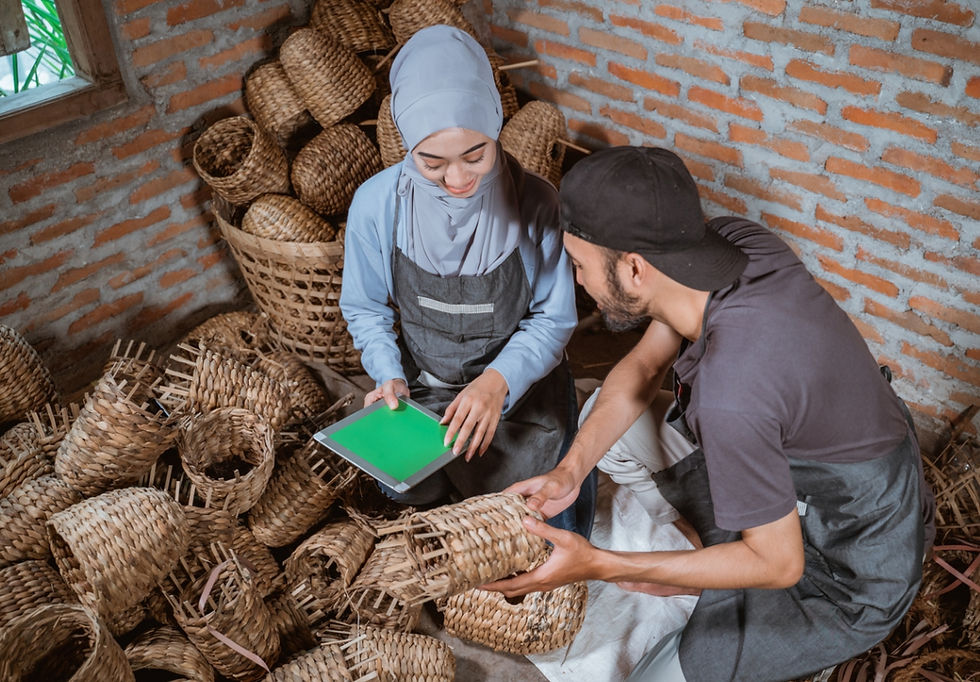Unlocking India's Payment Potential : How UPI Revolutionizes Transactions With Your Suppliers
- Bzaar Official Wix Account
- Feb 26, 2024
- 4 min read
Updated: Mar 13, 2024
If you’re an American retailer who has sourced from India or other Eastern countries, payments have most likely been a struggle if not a complete nightmare.
Navigating your way around traditionally cash-strapped economies, paying multiple vendors in your supply chain without incurring high international transaction fees, or having to make frequent cash advances to suppliers in a credit deficit system, can take a toll on your business (and mental) stability.
Luckily in India, business as usual with payments has drastically changed.
India’s Unified Payments Interface (UPI) can support you through your payment hurdles when doing business with Indian suppliers.
In 2016 India’s central bank launched UPI, which allows Indians to use a mere QR code or mobile number and transact virtually with other users in a matter of seconds. What began as a modest government experiment has turned India into the world’s largest real-time payments market–all in the span of a few years.

For December 2023, UPI payments in the country touched 12.02 billion transactions with payments worth INR 18.23 lakh crore or $243b. This represented a 54% year-on-year growth in terms of volume and a 42% growth in transaction value annually.
In an economy where the unorganized sector employs more than 50% of the workforce, UPI has accounted for almost 75% of total transactions in India’s retail segment from 2022-23.
From hawkers to restaurants, from teeming metros to remote hill stations, scan and pay is the new normal in India.
When UPI first launched, just half of Indians had a bank account. Now, that number stands at over 80%. A considerable public policy achievement anywhere, making the Indian economy digital-ready for business.
Particularly in India, with its diverse multiethnic, multilingual population of over a billion people, including many individuals who lack access to computers, the internet, and even electricity.
As India is likely to become the next global manufacturing powerhouse, find out how UPI works and how it can bridge payment gaps between you and your Indian suppliers.
How does UPI work?
Transferring money through UPI only requires Indian users to have a UPI ID – a unique identification for a bank account used to send and receive funds from one bank to another.
However, all UPI payment applications only need the receiver’s contact from your phone book or you can enter the receiver’s contact number to send money via UPI.
The UPI PIN, a 4 or 6-digit personal identification number is required to transfer money through the system.
What contributes to UPI’s success and popularity?

UPI needs a mobile phone and internet data to work. India’s mobile data rates are one of the cheapest in the world and it has a huge data-base of smartphone users – 750 million people from a population of 1.48 billion, that's almost 50%.
UPI has an extremely user-friendly design, for a population not accustomed to Internet banking.
A strong security system; with no major frauds reported since its inception.
UPI is free to use for consumers and most merchants; which is critical in a country where a majority of the population lives on a few dollars per day
How will UPI help my business?
In the handmade industry, the supply chain consists of multiple vendor payouts.
Traditional SWIFT payments can rack up fees as high as $10-$50 per transaction. Global teams can consider setting up a single Indian business account for their payouts.
Once this bank account is linked to UPI, vendor payments can be made with zero minimums and daily transaction limits as high as INR One Lakh ($1200) per day with major banks across the country.
2. Enabling cross-border payments through global partnerships
The National Payments Corporation Of India (NIPL) signed an agreement with Liquid Group to enable QR-based UPI payments for its citizens in 10 countries, including a large group of Southeast Asian nations like Malaysia, Thailand, Philippines, Vietnam, Singapore, Cambodia, South Korea, Japan, Taiwan, and Hong Kong.
As of last year, Non-resident Indians living in Western countries like Australia, Canada, the US, and the UK can also access the UPI transaction facility through their international numbers.
India’s UPI was recently linked with Singapore’s peer-to-peer fund transfer service, PayNow. Users can make instant remittances between the two systems, fostering transparent and inexpensive cross-border interoperability.
In 2019, Google recommended the US Federal Bank to replicate India’s UPI system. Last year, America’s Federal Reserve launched FedNow, the country’s national real-time payments platform. With UPI reportedly set to enter the Middle East and North American payment ecosystems, real-time remittance payments between India and the Western world have become a far more imaginable future.
3. Closing the credit gap for a stronger export supply chain
Previously, UPI was confined to bank accounts and RuPay credit cards. However, the recent update allows users to link UPI to loan accounts as well.
These pre-approved credit lines include – credit cards, small credit lines, and business credit lines. This initiative allows banks, NBFCs, PSPs, and FinTechs to devise innovative credit-oriented products facilitating integrated financing throughout the UPI transaction process.
This could be a game-changer for Indian suppliers, who contribute to a third of India’s national GDP, comprising almost half of all exports, and employ a fifth of the country’s workforce in India. However, they often face a shortfall in credit, estimated between US$250 and US$300b.
With UPI, India is destined to become a digital economy, where transacting with stakeholders across the supply chain will only evolve into an even more seamless, speedy, and trustworthy experience.
At Bzaar we handle end-to-end supply chains so that retailers can source hassle-free from India.
Payal Mohta is a freelance content writer, editor, and strategist. She writes about everything business and tech.



Comments